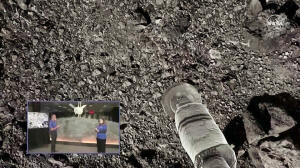NASA spacecraft grabs sample of rocks from asteroid
 Send a link to a friend
Send a link to a friend
 [October 21, 2020]
By Joey Roulette [October 21, 2020]
By Joey Roulette
WASHINGTON (Reuters) - A NASA spacecraft
touched down on the rugged surface of the Bennu asteroid on Tuesday,
grabbing a sample of rocks dating back to the birth of our solar system
to bring home.
The minivan-sized OSIRIS-REx spacecraft, built by Lockheed Martin,
extended its 11-foot (3.35 m) robotic arm toward a flat patch of gravel
near Bennu’s north pole and plucked the sample of rocks, the space
agency's first handful of pristine asteroid rocks.
"Sample collection is complete, and the back-away burn has executed,"
Lockheed mission operator Estelle Church added seconds later, confirming
the spacecraft eased away from the space rock after making contact.
The probe will send back images of the sample collection on Wednesday
and throughout the week so scientists can examine how much material was
retrieved and determine whether the probe will need to make another
collection attempt.

If a successful collection is confirmed, the spacecraft will journey
back toward Earth, arriving in 2023. Japan is the only other country to
have already accomplished this.
Bennu, located over 100 million miles from Earth and whose acorn-shaped
body formed in the early days of our solar system, could hold clues to
the origins of life on Earth, scientists say.
"Everything went just exactly perfect," Dante Lauretta, OSIRIS-REx
principal investigator from the University of Arizona, Tucson, said on a
NASA live feed from Lockheed's mission support building. "We have
overcome the amazing challenges that this asteroid has thrown at us, and
the spacecraft appears to have operated flawlessly."
The robotic arm's collection device, shaped like an oversized shower
head, is designed to release a pressurized gas to kick up debris.
[to top of second column]
|

A NASA probe orbiting an asteroid over 100 million miles from Earth
will make a perilous attempt on Tuesday to snatch a sample from the
celestial body’s rocky surface to bring home the space agency’s
first handful of pristine asteroid rocks. Gloria Tso reports.

The spacecraft launched in 2016 from Kennedy Space Center for the
journey to Bennu. It has been in orbit around the asteroid for
nearly two years preparing for the “touch and go” maneuver.
“A lot of things could go wrong because the spacecraft’s about the
size of a van, and the asteroid has a lot of boulders in it,” Lucy
Lim, a planetary scientist at NASA, said in an earlier interview.
“So we have to go between the boulders to get our sample, and a lot
of planning went into that.”
Asteroids are among the leftover debris from the solar system’s
formation some 4.5 billion years ago.
Scientists believe asteroids and comets crashing into early Earth
may have delivered organic compounds and water that seeded the
planet for life. Atomic-level analysis of samples from Bennu could
provide key evidence to support that hypothesis.
(Reporting by Joey Roulette; Editing by Bill Tarrant, Bill Berkrot
and Leslie Adler)
[© 2020 Thomson Reuters. All rights
reserved.] Copyright 2020 Reuters. All rights reserved. This material may not be published,
broadcast, rewritten or redistributed.
Thompson Reuters is solely responsible for this content.
 |